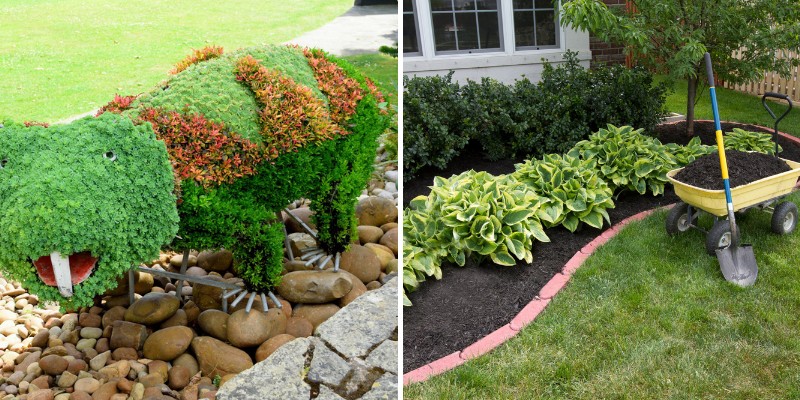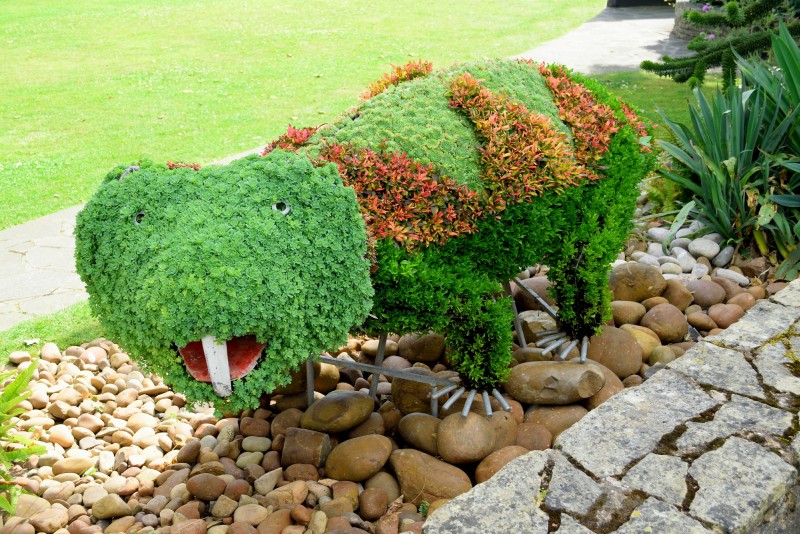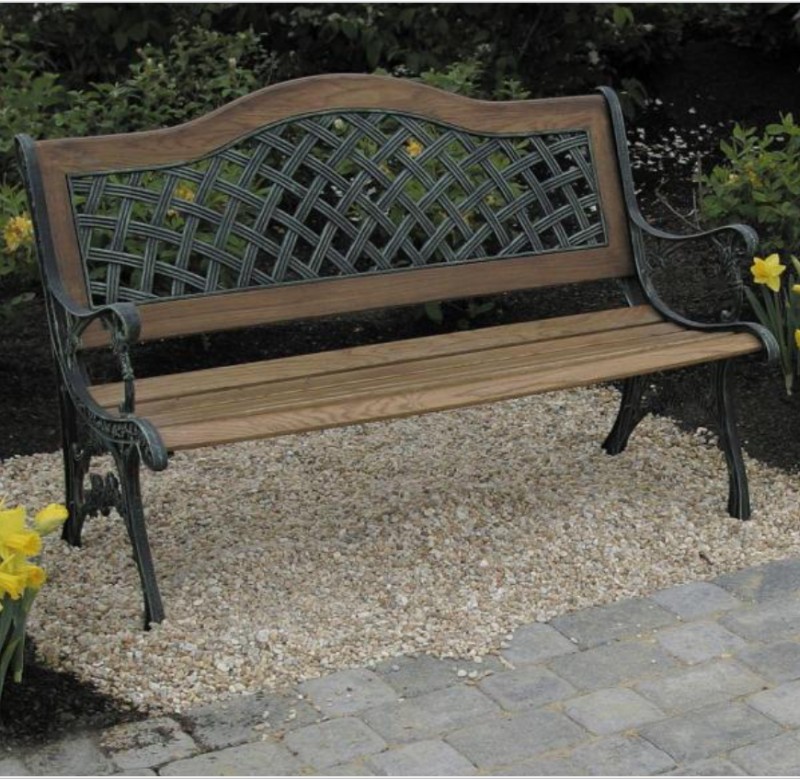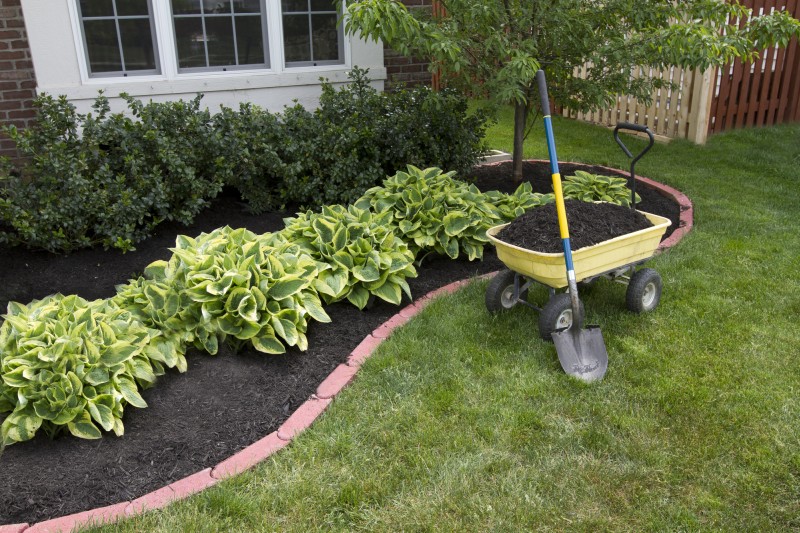You’ve got exciting goals for your landscaping project this year! You’re picturing thriving plants and tidy borders. Meanwhile, you’re pondering whether to choose decorative rocks or mulch.

Here you’ll learn the landscaping materials that foster vibrant plants and conditioned soil.
Certain products excel at curbing pests, weeds, and soil erosion. Others need minimal upkeep. I know you’re concerned about costs and aesthetics, too.
Then, I address FAQs about landscaping rocks and mulch. For instance, can you put rocks around plants instead of mulch? Is it better to put mulch or rocks around trees?
This post will help to actualize the thrilling plans you’re envisioning.
Let’s compare landscaping with rocks vs mulch with their pros and cons below:
Pros Of Landscaping Rocks
Outstanding Durability
Landscaping stones can handle heavy foot traffic without compacting. For this reason, they’re well-suited to garden paths and walkways.
Repel Insects
Since hardscape materials are inert, they don’t decay. Consequently, they have no appeal for bugs, unlike organic mulch.
Low Maintenance
Since rocks and stones don’t decompose like mulch, you won’t need to replenish them. Moreover, if their surfaces get covered with grass clippings or leaves, you can easily remove the debris with a leaf blower.
Excellent Soil Conservation
Stones and rocks anchor soil, preventing its depletion by wind and water. So, if you want to landscape a sloped yard, rocks are ideal, staying in place.
Fireproof
Do you live in a region prone to wildfires? If so, you can form a firebreak with landscaping rocks, helping to protect your property.

Less Expensive Overall
Initially, hardscape materials cost more than mulch. Additionally, you must buy fabric and metal guards to install them. Still, since you don’t need to replace rocks and stones, you’ll save money in the long run.
Promote Drainage
Does water collect on your property, forming residual puddles? If so, rocks and stones can improve drainage by directing the water elsewhere.
For instance, you can place large rocks strategically, diverting water from your home’s foundation. Or, use gravel to absorb water, sending any excess downward.
Note – Rocks will only improve drainage if water naturally flows away from your home. If not, consult a landscape professional to resolve puddling and flooding.
Cons Of Landscaping Rocks
No Nutritive Value
As mulch breaks down, it adds nutrients to your soil, improving its health and that of your plants. Conversely, rocks and stones lack this benefit.
Can Emit Harmful Heat
During summer, rocks absorb and hold the sun’s heat, releasing it as daylight wanes. Meanwhile, the soil temperature rises. In turn, plant roots lose moisture which jeopardizes their health. Thus, you’ll need to water more.
Heavy
Due to their weight, rocks can be cumbersome to handle.
Settle into the Soil
Since rocks are heavier than soil, they sink into the ground over time. For this reason, rocks alter the soil structure. Additionally, they interfere with tilling and planting.
Mediocre Weed Control
Generally, mulch outperforms landscaping rocks in discouraging weed growth. If you use large rocks, weed seeds can sprout in the spaces between them.
However, with small stones, weed growth is less likely due to the stones’ proximity to each other.
Types Of Landscaping Rocks
Hardscape materials impart a refined look to landscape features. Meanwhile, they enhance the beauty of flowers, plants, and trees.
Decorative rocks and stones come in various sizes, textures, and colors. Below are five of the most attractive types available at home improvement centers.
Lava Rocks
These irregularly-shaped rocks are the hardened residues of volcanic eruptions. Lava rocks are reasonably priced, sold in red, black, and gray. Especially stunning are lava rocks in terracotta red!
Since lava rocks are lightweight, you’ll find them easy to carry and install. If you have a rock or cactus garden, lava rocks are the perfect complement.
Black Polished Pebbles
Brick Chips
Although brick chips aren’t natural, they’re still categorized as landscaping rock. The chips are the product of crushed brick fragments. You’ll find them in a bevy of colors, including tan, slate, russet, apricot, and chocolate brown.
Crushed Stones
These landscaping elements have sharp, jagged edges and irregular shapes. Crushed stone sizes range from 3/8 inch to 4 inches.
Crushed stone is mined from various types of rock, such as limestone, granite, and sandstone. Thus, the quarry source determines stone color. Still, for landscaping purposes, most crushed stone is gray or white.
Pea Gravel

While pea gravel resembles crushed stone, it’s smaller with rounded edges. The size of pea gravel ranges from 1/8 inch to 3/8 inch. Additionally, it has a broader color palette than crushed stone, including red, brown, and blue.
River Rocks
These round stones come from fast-moving rivers, shaped by water erosion. River rocks have neutral colors and random sizes. Their soft hues and smooth texture are easy on the eyes.
Pros of Organic Mulch
Note – In this post, I’m comparing landscaping rocks with organic mulches, which are formerly live plant materials.

Nutrient-Dense
As organic mulch decomposes, it adds vital nutrients to your soil and plants. According to research, mulching trees can help them grow nearly twice as fast!
Insulates Soil
During winter, mulch enables soil to hold the sun’s warmth, helping vegetation adapt to plummeting temperatures. Then, in summer, mulch promotes cooler soil, protecting plant roots from drying out.
Good Weed Control
While mulch won’t eliminate weeds, it markedly hampers their growth.
Summons Beneficial Insects
Organic mulches attract desirable bugs, giving them shelter, warmth, and food. For instance, earthworms enhance soil texture and nutrient levels. Meanwhile, spiders consume bugs that ravage plant foliage.
Conserves Water
Mulch absorbs water, helping soil retain it, reducing evaporation and defending plants against drought. Consequently, you can water less frequently, conserving it. Moreover, you’ll have lower water bills during the growing season.
Curbs Soil Erosion
When you mulch, it shields the soil from moderate winds. Then, since mulch is spongy, it softens the impact of rain. Plus, it prevents water runoff. Do you have sloping property? If so, use shredded mulch, known for its superb erosion control.
Easy Installation
As mulch tends to be lighter than landscaping rocks, it’s easier to carry and spread. Moreover, you’ll spend less time applying mulch than installing rocks or stones.
Less Up-Front Cost
Mulch is cheaper than hardscape materials. If you’re landscaping a large area or need to save money, mulch is a good choice.
Cons of Organic Mulch
Tricky Timing
Since mulch insulates the soil, you must coordinate with nature to apply it. For example, in the spring, if you spread mulch before the ground warms, it can delay flowering. However, if you wait too long, weeds will take charge.
Needs Regular Upkeep
Many lightweight mulches require annual replenishing, such as shredded leaves and straw. Still, you can avoid this drawback by using wood chips or bark mulch.
Can Attract Pests
This is most likely with wood mulches, luring roaches and termites.
Loss During Forceful Storms
Gusty winds and heavy rain can displace lightweight mulch, such as straw.
Cumulative Expense
Since you must replenish mulch periodically, it costs more than landscaping rocks in the long run.
Types Of Organic Mulch
Below are four effective, easy-care organic mulches. Some are even free!
Straw
Typically, straw mulch comes from the stalks of harvested oats, barley, rice, or wheat, sold in bales. Unlike hay, straw doesn’t contain weed seeds.
Since straw breaks down slowly, you can apply it in the spring, and it will last the whole growing season.
Use straw mulch around growing fruit and vegetable plants, where it will guard the leaves from soil-borne diseases. For instance, straw is an excellent mulch for squash and strawberry plants.
Shredded Leaves
Leaf mulch is nutrient-dense, fostering the health of your soil and plants. Moreover, decaying leaves are food for earthworms. As they tunnel through the soil, they aerate it. Meanwhile, their waste or “castings” enrich the earth.
Are there trees on your property? If so, you have a free source of mulch! Moreover, you don’t need specialized equipment to shred fallen leaves. All it takes is a lawnmower with a bag attachment.
If you have a leaf-covered lawn, when you mow it, the machine will shred the leaves automatically. If the fallen leaves are elsewhere, gather them into piles. Next, feed the foliage into the mower. Then, lay the chopped leaves anywhere on the soil of your property.
Wood Chips
Typically, wood chips are dried and aged before bagging them. The materials can be dyed brown, black, or red, making them potentially toxic for your plants. For this reason, choose unpainted wood chips.
Do you live in an urban area? If so, you may have access to free wood chips. Some municipalities offer them to homeowners as a free service. Or, check with a local tree care company, another possible source of wood chips at no charge. Otherwise, you’ll find low-cost wood chips at garden centers and home improvement stores.
Note that fresh wood chips absorb soil nitrogen. Therefore, avoid using them to mulch flower beds and vegetable plants. Instead, place new wood chips around mature shrubs, fruit trees, and woody perennials. Or use them for walkways and shrub borders.
Bark Mulch and Chips
Bark mulch is either shredded or in nuggets, obtained from pine, fir, spruce, and hemlock trees. On the other hand, bark chips come from Douglas fir, available in various sizes. Avoid using cedar mulch due to its acidity.
Frequently, bark chips and mulch comprise the wood waste from sawmills and furniture producers. Rather than disposing of the wood, the companies sell it to home improvement stores and garden centers. In that case, the wood is recycled. Still, avoid purchasing dyed products.
Processed tree bark also draws nitrogen from the soil. So, before spreading bark around plants, you must age it for at least one year. Or, use fresh bark for garden paths, shrub borders, and walkways. Bark mulch and chips can last for seven to 10 years!
Pine Needles
Since pine needles have a wispy texture, they make an attractive mulch. Meanwhile, pine needles have good longevity, enduring for several years. If you have pine on your property, celebrate your good fortune! Use the fallen leaves for mulch. If not, garden centers sell pine mulch at reasonable prices.
Still, pine needles are highly flammable. So, avoid using this mulch if you live in a wildfire danger zone.
FAQs About Landscaping With Rocks And Mulch
Is it better to put mulch or rocks around trees?
Around trees, it’s best to lay a foundation of mulch, installing rocks above it. If you apply mulch alone, it will need regular maintenance.
On the other hand, if you install rocks without a barrier, tree roots can dehydrate since rocks emit solar heat. Additionally, mulch keeps decorative stones from altering the soil pH.
While you can use landscape fabric under decorative rocks, it has no nutritive value for a tree and its soil.
The best biodegradable mulches for trees are wood chips and shredded bark. Here’s how to landscape around a tree with mulch and rocks.
- Remove any turf grass around the trunk.
- Gauge the trunk’s dripline, a guide to the tree’s primary root zone.
With a large tree, it’s the outermost reach of the canopy where rain drips from the branches to the ground. For a small tree, take the trunk diameter and multiply the number by 1.5. The answer is the root radius in feet.
- About 6 inches from the trunk, apply a 3-inch layer of mulch to the dripline. A 6-inch ring of bare ground is essential. If you pile mulch against the tree, moisture will build, causing the trunk and the roots below to rot.
Can you put rocks around plants instead of mulch?
Mulch is healthier and safer than rocks for flowers, plants, vegetables, and shrubs. Such vegetation is highly vulnerable to the heat emitted by sunbaked rocks.
Moreover, mulch releases nutrients as it decays, whereas rocks don’t decompose. Mulch also retains moisture better than rocks. Do you have young children? If so, they might use rocks and stones as toys, tossing them around and getting hurt. Thus, mulch is a safer choice.
If you prefer the aesthetics of decorative rocks, use them as a border around mulched vegetation. To prevent rot, ensure at least 4 inches of space between the base of each plant and the rocks.
How often should you replenish mulch?
In the spring, replenish last season’s mulch if the material is:
– discolored
– sprouting weeds
– showing signs of decomposing
– less than 2 inches deep
If the mulch isn’t soggy or rotting, remove any weeds. Next, use a shovel to mix and turn the mulch, loosening the material and breaking up any clods.
Then, refresh the mulch by spreading a thin layer of new material on top. Be sure to use the same type of mulch.
Also, avoid building it to a 4-inch depth. Otherwise, the plant roots will eventually drown or choke from lack of air.
Should you remove old mulch before adding new material?
Eliminate mulch that’s waterlogged, rotting, or rigidly compact. Also, extract old mulch before tilling a plant bed and adding soil conditioners, such as compost or manure. Then, if the former mulch is still serviceable, reapply it, adding new material to a total depth of 2 inches.
Lovely Landscape
Let’s recap the key points of our discussion.
Pros of Landscaping Rocks
- improve drainage
- excellent for preventing soil erosion
- ideal for garden paths, walkways, and rock gardens
- repel insects
- can serve as a firebreak
- low maintenance
- don’t need replacing, saving you money long-term
- impart sculptural beauty to your property
Cons of Landscaping Rocks
- have no nutritional benefits for plants and soil
- weeds can sprout in the gaps between rocks
- emit solar heat during summer, drying plant roots
- hard to haul and install due to their weight
- interfere with tilling and planting
- costly
Pros of Mulch
- provides nutrients to soil and plants as it decomposes
- insulates soil, keeping it warmer in winter and cooler in summer
- absorbs water, making it available to plants and guarding against drought
- inhibits weed growth
- aids in preventing soil erosion, though not as well as landscaping rocks
- attracts beneficial insects, such as spiders and earthworms
- easy to carry and spread
- affordable
Cons of Mulch
- needs timely application to promote flowering and block weeds
- wood mulches can attract pests, such as roaches and termites
- can be displaced by heavy rain and blustery wind
- requires refreshing, replenishing, and replacement over time
- is an ongoing expense since mulch gets depleted
Meanwhile, landscaping rocks and mulch complement each other. Thus, you can reap the benefits of each by using them concurrently.
For instance, when landscaping around trees, start with a mulch foundation. Then, lay your decorative stones on top.
So, when landscaping your property, consider appointing rocks and mulch. Enjoy the best of both!
Related Posts
- 6 Different Types of Soil for Gardening – How to Identify and Improve Each Type
- How to Create a Low Maintenance Garden
- 5 Benefits of Having Artificial Grass for Your Pets to Play On
- 12 Main Pros and Cons of a Pea Gravel Patio for Your Home
- Want to Redo Your Lawn? Here Are Your Options
- How to Fix and Dry a Muddy Yard – Here Are Several Effective Ways
Leave a Reply